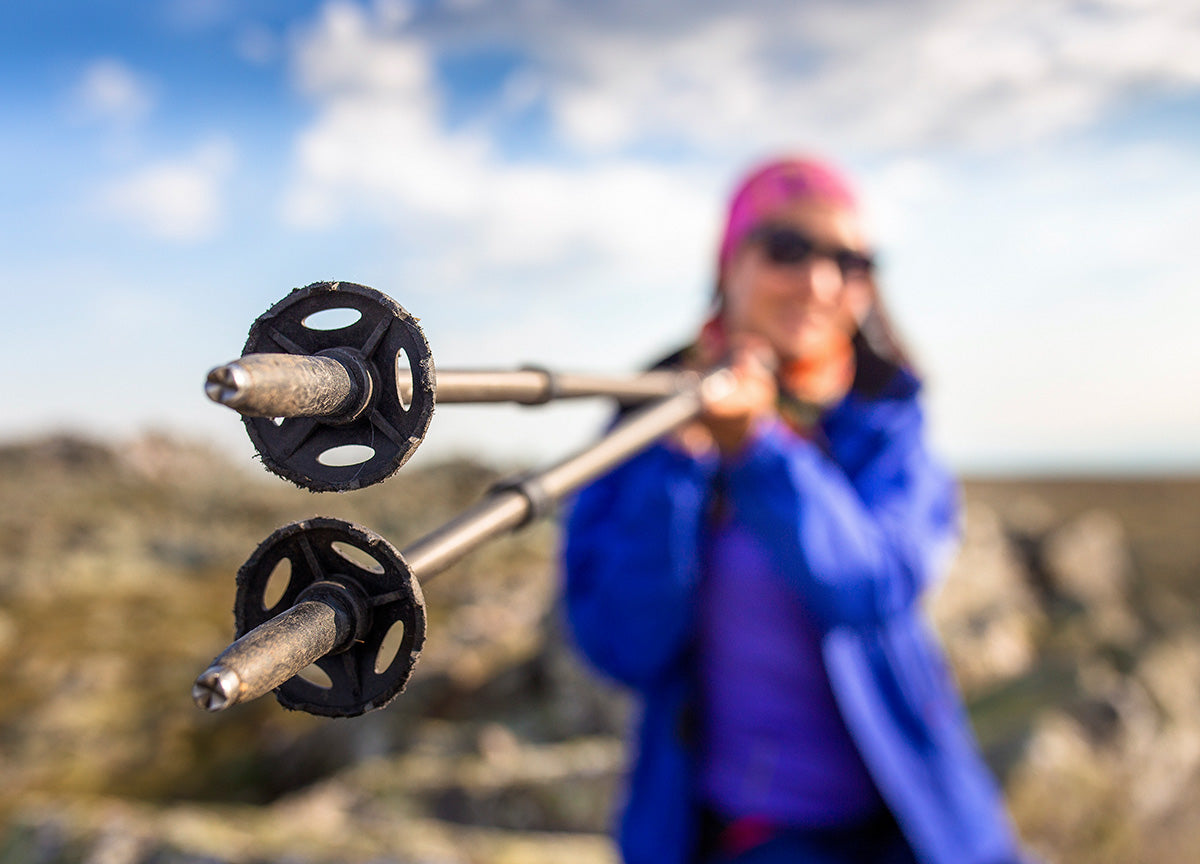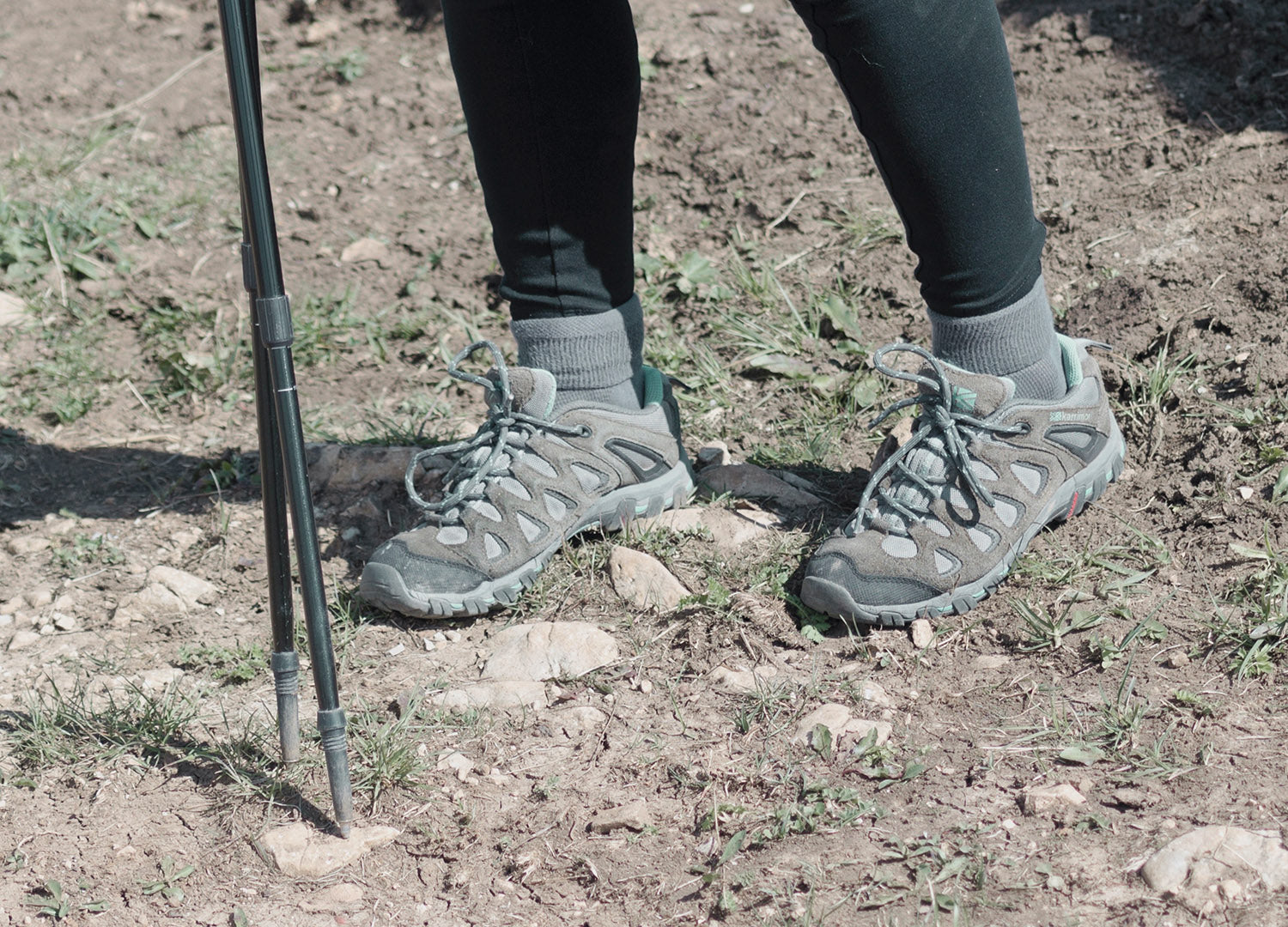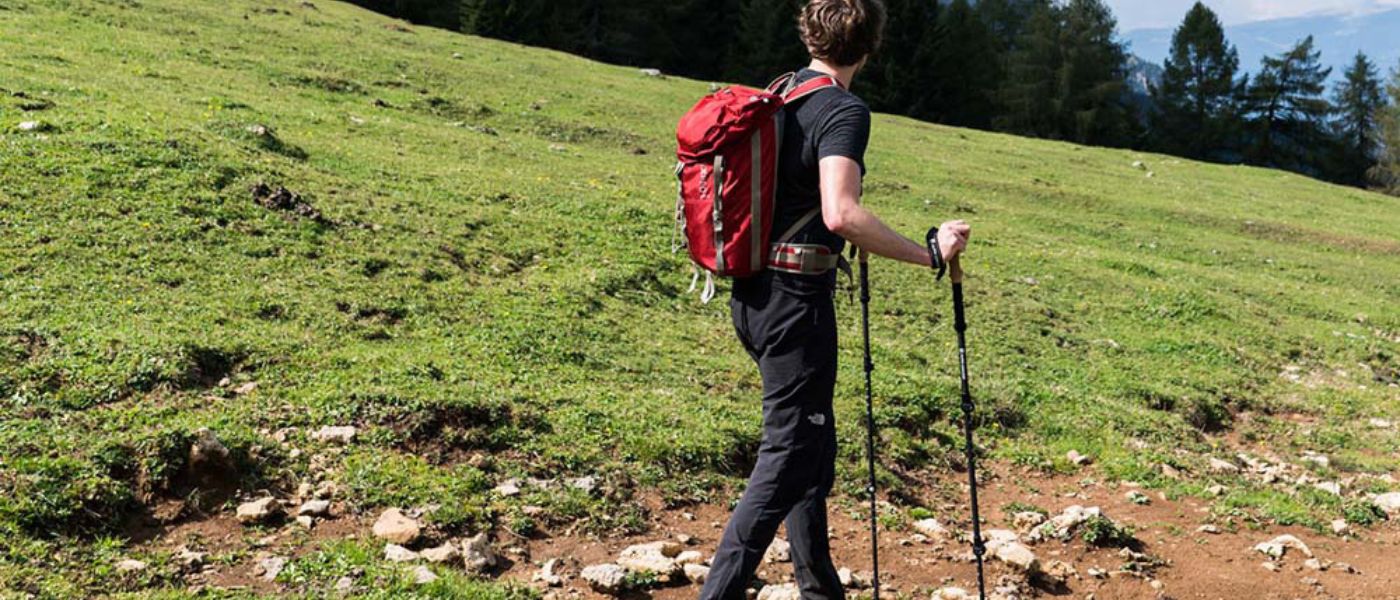Attachments for hiking poles
Trekking poles have four different buffers for tips. Which hiking pole tips are right for you depends on the terrain and the activity.
Asphalt tops
Asphalt tips are, as the name suggests, used on very hard surfaces. Concrete or asphalt surfaces damage the tip of the cane if used continuously. That is why there is a small black rubber shoe to protect the tip of your walking aid.

It makes no sense to combine rubber feet for asphalt with mud plates. The two components are for completely different terrain.
Important: Rubber tips are never used in the mountains! The rubber buffer on the tip of the pole prevents a proper grip!
Nordic Walking attachments
There are different attachments for Nordic walking poles. On the one hand there are the above-mentioned asphalt attachments, and on the other hand there are rubber bumpers that look like small shoes. Rubber bumpers for Nordic walking attachments are rounded on the underside. This makes it easier to walk quickly so that you can build up even more speed.

Nordic walking attachments can be used for different outdoor surfaces: Asphalt, meadow, gravel path and forest floor, if it is not too soft.
Mud tops
Mud plates prevent the pole from sinking into sand, earth or mud. In addition, the mud cap is an aid for the tip of the pole to prevent it from sinking too deeply into scree or slipping into small crevices and becoming trapped. Mud attachments for hiking poles have a screw thread and are screwed onto the tip of the pole.

Mud platter attachments for hiking poles have a smaller diameter than snow platters.
Snow attachments
Snow plates are specially made for the cold season. This pole attachment for winter can be used not only for walking in the snow, but also for snowshoe hiking.
Snow plates are used for touring, especially in winter. Whether you are a skier or snowboarder, hiking poles with snow plates will make your ascent much easier. If you are a snowboarder and do not use your poles for the descent, we recommend lightweight, foldable trekking poles that can be stowed in your rucksack during the descent.

Snow plates are screwed onto the tip of the pole in the same way as mud plates.
Attachment Use without rubber buffer
You shouldn't use attachments whenever you are walking on soft surfaces. This is, for example, the forest floor or snow.
You don't need any extra pads here, as the penetration of the tip provides significantly more grip. If the ground is too soft, use the plates again so that your pole tips don't get stuck. If the snow is powdery and you can sink into it, you would, for example, revert back to using the tips.

In this rather dry terrain, hiking poles without a tip are used. The tip provides sufficient grip. The hiking poles cannot sink in and therefore do not need a mud cap.
Related blog posts
Using hiking poles correctly: How hiking poles really make a difference
Walking poles are not just for older people. Hikers of all ages benefit from using poles. With the right walking technique, they can support your footwork and sense of balance in the best possible way. Trekking poles also help to protect your joints.
However, there are a few points to bear in mind when using them, which we will show you in the following blog post.
When should you use hiking poles use?
Hiking poles are a valuable companion on any hike. It is particularly worth using poles for ascents and descents. They reduce your effort and the strain on your legs.
- Muscles,
- Tendons
- and joints.
But even on rough terrain, trekking poles always give you the edge. Especially on slippery, stony or muddy terrain, they offer you the best possible grip and prevent you from slipping.
Are you more of a video person? No problem, in our buying guide we go into the topic in detail
Video advice on hiking poles " How to find the right hiking poles
What are the advantages of using walking poles?
Experienced and sure-footed hikers can use poles in places to take the strain off their knees and improve their balance. Nevertheless, the body should have the opportunity to move freely (without poles) often enough to train the sense of balance.
When the telescopic walking poles are not in use, they should lie loosely in the hand and be held centrally. Then they won't get in the way.
Can hiking poles also be used when hiking in the snow?
Yes! Various attachments are included with our telescopic and folding poles. The so-called snow plates are primarily designed for use in snow. So nothing stands in the way of a winter snow hike. Trekking poles can also serve you well in other seasons. The attachments can be replaced in no time at all and offer you the right grip in any weather and on any surface:
- Snow plates are ideal for hiking in the snow.
- Asphalt attachments are suitable for use on hard surfaces.
- Poles without rubber pads have proved their worth on dry mountain terrain. (If there is a lot of debris, you can also use the mud tops to prevent sinking.
- Mud inserts are ideal for sand, earth and mud.
- Nordic walking attachments facilitate fast walking on firm ground.
Hiking correctly with poles: These techniques are available
It is well known that many roads lead to the same destination. This also applies to the walking stick technique. The following three techniques are used:
1. the diagonal technique:
This technique is used on moderate terrain. This includes mainly flat routes with a slight incline.
- As you are used to from walking, arms and legs are moved in opposite directions.
- If your left leg is in front, the right pole is used at the same time - and vice versa.
You can therefore use this diagonal technique quite intuitively.

2. the double-decker insert:
With double-decker technology, you are well catered for on steep terrain.
- Both sticks are placed clearly in front of the body and feet.
- Then walk between them in two to four steps.
- On steep cross-country trails, it is a good idea to hold the poles at different heights: On the uphill side below the grip - on the downhill side you can lean on the pommel.
3. the lateral support method:
This method is used in extremely steep terrain.
- Here you must grasp one or both sticks.
- You grip the pole with your uphill hand near the tip and with your downhill hand for about two thirds of the length or at the handles.
- Then place the tip in front of your body (to the side and at about hip height) on the slope.
- The arm on the uphill side is stretched and the body is supported on this side, the other hand presses the poles against the slope.
- You take two steps, then the whole thing is repeated.
Expert tip: When descending, you can use the poles only relieve the strain on your knees if you place them parallel in front of your body. This involves bringing your upper body forward and bending your legs in order to place the poles far forward and down.
The poles are only used every two to three steps. On steep slopes, the walking poles must be set a little longer on the descent.
When should trekking poles not be used?
In rocky terrain where there is a risk of falling, the poles should be in the outdoor rucksack in your outdoor rucksack. They absolutely do not belong on your wrists. Hiking poles on the outside of the rucksack you should make sure that the poles are attached correctly. Otherwise they can become an obstacle.
Stick bows
The loops of the walking poles should really only be used on completely flat terrain. Otherwise, if your hands are in the pole loop and you stumble, you will be "tied up" and unable to hold on or support yourself.
Conclusion
If hiking poles are used correctly, they provide valuable support on every tour. Even if the diagonal technique requires no prior knowledge and is used intuitively, it should not be used in all terrain. On steep terrain in particular, you should opt for the double pole or side support method.
FAQ
Can I also use hiking poles on steep downhill climbs?
Yes, of course you can use hiking poles downhill. Hiking poles are also helpful equipment for steep descents. Here it is best to use the side support method as described above.
Use one or two walking poles?
You have to decide for yourself whether to take one or two walking poles. Experience has shown that it is advisable to take two poles for longer hikes and the corresponding luggage. However, for shorter excursions on flatter terrain, you can also set off with one trekking pole without any problems.
How do I store my walking poles when I'm not using them?
If you don't need your hiking poles, they are best kept in your rucksack. Telescopic poles can be folded up in a few simple steps.
Foldable hiking poles can be folded up in no time at all. Thanks to their small pack size and weight, both models fit into any hiking rucksack.
Want to know more about hiking poles? Read on right here:




